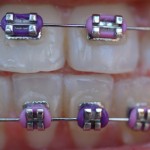
It has been suggested that treatment efficiency is improved with self-ligating orthodontic bracket systems by reducing the number of appointments and overall treatment time. Initial studies did identify reductions in treatment time but higher quality studies found no differences between the two approaches. The aim of this study was to determine whether a self-ligating bracket system (3M SmartClip) increased the efficiency of treatment as compared to brackets using conventional ligation (3M Victory).
Methods
Patients requiring upper and lower fixed appliance treatment using preadjusted edgewise appliances, were invited to participate in the study. Patients, with cleft lip/palate or who had other syndromes, hypodontia with more than one missing tooth per quadrant or required orthognathic surgery, were excluded.
Patients were block randomised to either self-ligating or conventional ligation with stratification for each operator. A standardised treatment procedure was used with bands on molar teeth and brackets bonded on incisors, canines and premolars. The manufacturer’s recommended archwire sequence at the time of the study was used for each appliance system as far as possible
The following outcomes were measured:
- Total duration of treatment (months) from fixed appliance placement to debond;
- Total number of appointments, including scheduled and unscheduled visits from start of treatment to debond; and
- Number of bracket bond failures, involving only first time failures for each tooth (multiple breakages on the same tooth were not recorded).
Results
- 138 patients were recruited with 135 (97.8%) completing the study.
- No significant differences were found between the bracket systems in any of the outcome measures.
| Self-ligating | Conventional ligation | ||
| Mean treatment time | 25.12 months | 25.80 months | NS |
| Mean no. visits | 19.97 | 20.37 | NS |
| Bond bracket failure | 6.6% | 7.2% | NS |
- No serious harm was observed from either bracket system
Conclusions
The authors concluded: –
There was no clinically significant difference in treatment efficiency between treatment with a self-ligating bracket system and a conventional ligation system.
Comments
This randomised controlled trial has essentially focused on process outcomes rather than clinical outcomes and has demonstrated no differences between self-ligating or conventional ligation orthodontic bracket systems. These findings are similar to other recent trials and a systematic review that also found no difference between the two system types (Dental Elf – 23rd May 2014).
In a separate paper (Rahman et al, 2015), the patient’s pain perception is reported using a Verbal Rating Scale to assess discomfort felt on the teeth and soft tissues at the time of the appointment and 1, 3, and 5 days after each archwire change up to the working archwire. While perceived pain was statistically higher with the self-ligating system, it was not considered to be clinically significant.
Links
O’Dywer L, Littlewood SJ, Rahman S, Spencer RJ, Barber SK, Russell JS. A multi-center randomized controlled trial to compare a self-ligating bracket with a conventional bracket in a UK population: Part 1: treatment efficiency. Angle Orthod. 2015 Apr 8. [Epub ahead of print] PubMed PMID: 25853795.
Rahman S, Spencer RJ, Littlewood SJ, O’Dywer L, Barber SK, Russell JS. A multicenter randomized controlled trial to compare a self-ligating bracket with a conventional bracket in a UK population: Part 2: Pain perception. Angle Orthod. 2015 Mar 26. [Epub ahead of print] PubMed PMID: 25811246.

Self-ligating orthodontic brackets not more efficient that conventional systems. http://t.co/p5uovYljM9
No difference between self-ligating and conventional orthodontic systems. http://t.co/p5uovYljM9
Orthodontic treatment efficiency not improved with self-ligating systems. http://t.co/p5uovYljM9
No difference in orthodontic treatment efficiency between self-ligating and conventional ligation systems. http://t.co/p5uovYljM9
Don’t miss – Self-ligating orthodontic bracket system did not increase treatment efficiency. http://t.co/p5uovYljM9
[…] http://www.thedentalelf.net/2015/07/10/self-ligating-orthodontic-bracket-system-did-not-increase-tre… […]